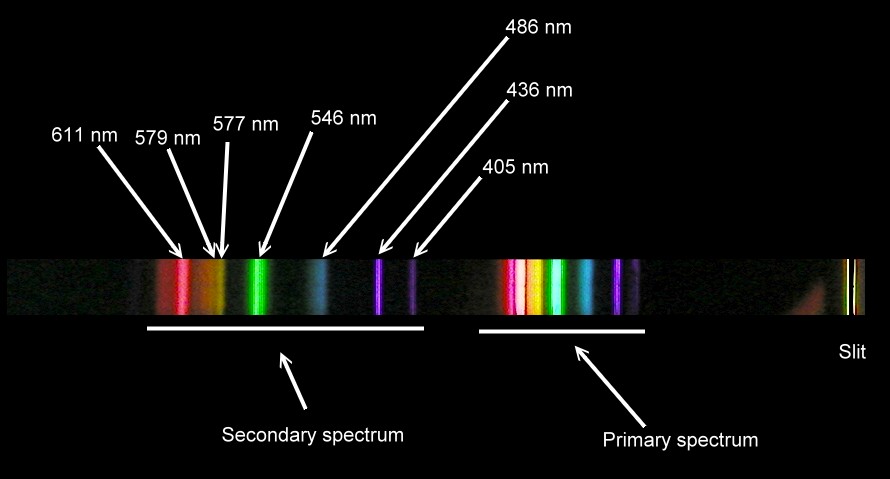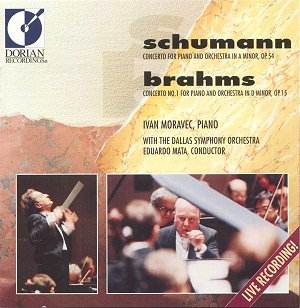Thursday, April 25, 2013
Spectrum of a sodium vapor street light
I took the Carolina $10 spectroscope outside to observe the spectrum of a sodium vapour street lamp (the orange coloured ones). I read lines at 500 nm, 515, nm and 590 nm. Here is the sodium spectrum
Looking at the two part spectrum the lines I observed are indicated with arrows. I also observed some of the blue lines, but couldn't make out the position on the ruler.
Monday, April 22, 2013
Cheap spectroscopy
I bought a $10 Carolina spectroscope from Merlan. I pointed it at a CFL bulb and took a photo of the spectrum:
Now compare it to the mercury spectrum:
The spectrum peaks are at 435.835 nm (blue), 546.074 nm (green), a pair at 576.959 nm and 579.065 nm (yellow-orange). There are two lines at 404.656 nm and 407.781 nm and a faint line at 491.604 nm.
Compare this to the labelled spectrum of a fluorescent light from this site:
You can actually see the purple line with the spectroscope (it doesn't show up on the photo). When I read the wavelengths from the spectroscope, it matches the numbers shown in the reference photo. This is pretty good for $10!
When I pointed the spectroscope at a halogen lamp, the spectrum was more like a rainbow (full spectrum lighting). This simulates natural sunlight much better than a CFL. This link explains this phenomena very well.
A complete library of atomic spectra is found here. This is very old, but it shows how to take better pictures of spectrometer spectra (click here).
I've also used this to look at the spectrum of a sodium vapour street light.
Sunday, April 21, 2013
Dorian Recordings
In the 1990s, BMG Music Service setup shop in Canada briefly and competed with Columbia House. It was great as I now had access to the PolyGram catalog (DG, Decca, Philips) at a discount. They also happened to offer CDs from Dorian, a small American lablel. Along the way, I was introduced to Custer LaRue's recording of American folk songs by Bob Kerr (CBC Stereo, Off the Record).
One of the songs on this CD was the theme to the Friendly Giant. Bob Kerr also introduced me to Juilanne Baird's recording of John Downland's song, Come Again (sheet music here). Sting has performed this song too. I had not listened to this Julianne Baird CD for maybe 10 years and I pulled it out yesterday to listen to it. Glorious! It is certainly a young person's song.
Also, I heard about "The Art of the Bawdy Song" with the Baltimore Consort. Rather more boorish music (and lyrics) here.
I was drawn back to these Dorian Recordings because on April 18th, my recording of Ivan Moravec playing the Schumann and Brahms Piano concerti arrived. I had tried unsuccessfully to get it new from Amazon.ca, but an Ontario seller on Amazon.ca Marketplace had a used one for sale. I've been listening to a lot of Ivan Moravec's Chopin from his Vox recordings lately.
How lucky that I have these fabulous Dorian CDs in my collection!
One of the songs on this CD was the theme to the Friendly Giant. Bob Kerr also introduced me to Juilanne Baird's recording of John Downland's song, Come Again (sheet music here). Sting has performed this song too. I had not listened to this Julianne Baird CD for maybe 10 years and I pulled it out yesterday to listen to it. Glorious! It is certainly a young person's song.
I was drawn back to these Dorian Recordings because on April 18th, my recording of Ivan Moravec playing the Schumann and Brahms Piano concerti arrived. I had tried unsuccessfully to get it new from Amazon.ca, but an Ontario seller on Amazon.ca Marketplace had a used one for sale. I've been listening to a lot of Ivan Moravec's Chopin from his Vox recordings lately.
How lucky that I have these fabulous Dorian CDs in my collection!
Monday, April 15, 2013
Sir Colin Davis
This morning, I heard the news of Sir Colin Davis' passing from an e-mail from Presto Classical. I admired Sir Colin Davis for his Mozart conducting. As a high schooler, I enjoyed the Philips records he made with Stephen Kovacevich. The first Davis recording I had was a Philips Festivo LP of Mozart's Prague and Jupiter symphonies. It was one of the first recordings of the Jupiter in which I heard the repeats in the final movement.
This morning, it happened that their recording of Mozart's KV 467 was playing in my car. I think that is my favorite recording of KV 467. Kovacevich's ornamentations in the slow movement really caught my ear the first time I heard it.
He is a musician I will miss, but we are so lucky that his recordings live on.
He is a musician I will miss, but we are so lucky that his recordings live on.
Saturday, April 13, 2013
Some irrational beauty of mathematics
In computer science, I often refer to two infinite alternating series:
ln(2):
and the Leibniz expansion of π/4:
When I saw these two infinite series in first year calculus, I was fascinated that such a simple pattern would result in something meaningful (it made me think there must be a God indeed!).
Now, π is a familiar irrational number, but e (Euler's number) is less well know. When I took MAT319, Introduction to Complex Analysis (the only optional math class I ever took as an undergrad), we were shown de Moivre's formula
and we were shown the much simpler Euler formula:
This is the formula Richard Feynman called "one of the most remarkable, almost astounding, formulas in all of mathematics." Why is this so important? Well, the Fourier transform requires this remarkable fact!
It is much easier to deal with exponentials than trig functions, so Fourier transforms are usually expressed as above. Why are Fourier transforms so important? Well, any application of digital signal processing requires it! When we try to remove noise from a signal (TV, radio, seismic etc), we need to be able to find the frequencies in the signal and the Fourier transform does that for us. So the images we see from various earth orbiting satellites like RadarSAT would not be possible without the Fourier transform (and Euler's formula). Euler's number (e) is a remarkable number indeed!
This example of using Audacity to analyse sound uses the Fourier transform. The frequency spectrum was computed with a Fast Fourier Transfer (FFT).
Now, I am not very good at mathematics, but I do admire and appreciate it's beauty and utility. That's probably why I admire Michael Faraday above all other scientists (he wasn't very good at math like James Clerk Maxwell was). When some of my computer science students said "your smart", I rebutted, "no I'm not" and told the story of my ordeal in APM346 (Partial Differential Equations). The class was taught by G F D Duff, FRSC. I was confused from the very start because he used a different notation from the textbook he assigned (and I'm just not that great at math). When he walked in to return the midterms, he said "the grades ranged from 0 to 100%. The class average was 33%" and then proceeded to get on with the class. The guy sitting next to me said "Hey, I did twice as well as you - I got 2/20". Seeing failure in my future, I went to see a physics prof and asked if I could take the geophysics classes next year if I failed the class. He told me "stay in the class, if he doesn't change the grade, governing council will". So, I stayed in the class, didn't bother to study for the 60% final (because I had quantum mechanics the day before and was in low spirits), answered only 2 of the 6 question on the final exam (I was admiring the woodwork in West Hall, University College for the last 15 minutes contemplating my failure). I got 52% (D-) and was so happy to pass!
It's not being 'smart' that matters. It's the willingness to learn something new. And, as I get older, I realise that if something is difficult, it means I'm actually learning something new. One of the concepts from APM346 that confused me was Bessel Functions. During coffee break in grad school, one of my colleagues moved his styrofoam cup across the table and said, "look at the Bessel functions" in response to the ripples that were forming in the cup. It was at that time it dawned upon me that Bessel functions are used to solve boundary value problems in cylindrical coordinates. You don't have to know why they work (at least as a scientist), you just have to know that for cylindrical geometry, Bessel functions work! And, for spherical coordinates, Legendre polynomials work (I heard that in Derek York's Physics of the Earth class in fourth year).
ln(2):
and the Leibniz expansion of π/4:
When I saw these two infinite series in first year calculus, I was fascinated that such a simple pattern would result in something meaningful (it made me think there must be a God indeed!).
Now, π is a familiar irrational number, but e (Euler's number) is less well know. When I took MAT319, Introduction to Complex Analysis (the only optional math class I ever took as an undergrad), we were shown de Moivre's formula
and we were shown the much simpler Euler formula:
This is the formula Richard Feynman called "one of the most remarkable, almost astounding, formulas in all of mathematics." Why is this so important? Well, the Fourier transform requires this remarkable fact!
It is much easier to deal with exponentials than trig functions, so Fourier transforms are usually expressed as above. Why are Fourier transforms so important? Well, any application of digital signal processing requires it! When we try to remove noise from a signal (TV, radio, seismic etc), we need to be able to find the frequencies in the signal and the Fourier transform does that for us. So the images we see from various earth orbiting satellites like RadarSAT would not be possible without the Fourier transform (and Euler's formula). Euler's number (e) is a remarkable number indeed!
This example of using Audacity to analyse sound uses the Fourier transform. The frequency spectrum was computed with a Fast Fourier Transfer (FFT).
Now, I am not very good at mathematics, but I do admire and appreciate it's beauty and utility. That's probably why I admire Michael Faraday above all other scientists (he wasn't very good at math like James Clerk Maxwell was). When some of my computer science students said "your smart", I rebutted, "no I'm not" and told the story of my ordeal in APM346 (Partial Differential Equations). The class was taught by G F D Duff, FRSC. I was confused from the very start because he used a different notation from the textbook he assigned (and I'm just not that great at math). When he walked in to return the midterms, he said "the grades ranged from 0 to 100%. The class average was 33%" and then proceeded to get on with the class. The guy sitting next to me said "Hey, I did twice as well as you - I got 2/20". Seeing failure in my future, I went to see a physics prof and asked if I could take the geophysics classes next year if I failed the class. He told me "stay in the class, if he doesn't change the grade, governing council will". So, I stayed in the class, didn't bother to study for the 60% final (because I had quantum mechanics the day before and was in low spirits), answered only 2 of the 6 question on the final exam (I was admiring the woodwork in West Hall, University College for the last 15 minutes contemplating my failure). I got 52% (D-) and was so happy to pass!
It's not being 'smart' that matters. It's the willingness to learn something new. And, as I get older, I realise that if something is difficult, it means I'm actually learning something new. One of the concepts from APM346 that confused me was Bessel Functions. During coffee break in grad school, one of my colleagues moved his styrofoam cup across the table and said, "look at the Bessel functions" in response to the ripples that were forming in the cup. It was at that time it dawned upon me that Bessel functions are used to solve boundary value problems in cylindrical coordinates. You don't have to know why they work (at least as a scientist), you just have to know that for cylindrical geometry, Bessel functions work! And, for spherical coordinates, Legendre polynomials work (I heard that in Derek York's Physics of the Earth class in fourth year).
Subscribe to:
Posts (Atom)














